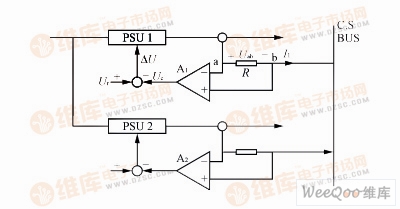The automatic current sharing method is also called the single line method. Its working principle is that each power module is connected to a current sharing bus through a current sensor and a sampling resistor.
As shown, when the output reaches current sharing, the output current I1 is zero. On the contrary, the current R1 flows through the resistor R, and a voltage Uab is generated at both ends thereof. This voltage passes through the output voltage Uc of the amplifier A, and the ΔU which is compared with the reference voltage Ur is fed back to the control portion of the power module, thereby Adjust the output current to achieve current sharing.

Single line method working principle circuit diagram
The advantage of the automatic current sharing method is that the circuit is simple and easy to implement. The disadvantage is that if one module is shorted to the current sharing bus, the system will not be evenly currentd, and a single module current limit may also cause system instability.
If the resistor in the figure is replaced by a diode, the diode is positively terminated a and the negative terminal is connected to b. Thus, among the N parallel power supply modules, only the current of the module with the largest output current can make the diode connected to it conduct, so that the current sharing bus voltage is equal to the output voltage of the module, and the other modules are on the current sharing bus. The voltage is used as a reference to regulate the respective output currents to achieve current sharing.
Suizhou simi intelligent technology development co., LTD , https://www.msmsmart.com